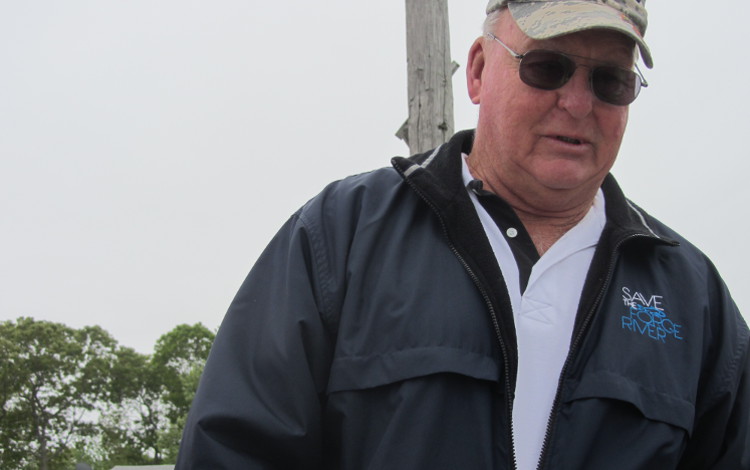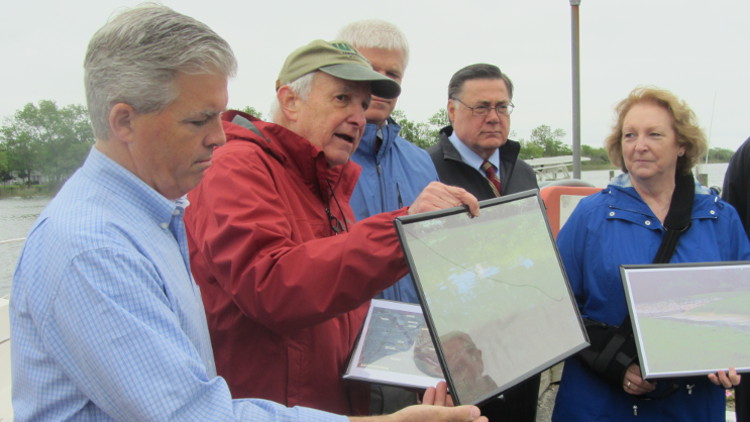Long-time Mastic resident John Dolezal doesn’t have to look out the window and know that Wills Creek—one of the most polluted tributaries of the Forge River—has turned milky white. He can tell by the foul odor in the air.
“It smells like a sewer,” he says. “Like cesspool trucks had been dumping in there.”
And, in a way, they have. The nearby duck farms are long gone but decades of duck manure have been coagulating on the river bottom along with the overflow from outmoded cesspools and leaky septic systems in a watershed that is sorely in need of a sewage treatment system.
In July, when the rising water temperature reaches the 70s, says Dolezal, one of the founding members of the Save the Forge River coalition, the “bottom starts cooking” and the result is that the creek surface looks like a cappuccino.
Researchers who’ve been studying the Forge River think the milky residue is caused when the high levels of sulfide in the creek oxidize in the summer heat.
“I have seen it mostly along the bank on the north side,” said Larry Swanson, director of the Waste Reduction and Management Institute at Stony Brook University. He said Wills Creek is “one of the most polluted bodies of water here.”
The catalyst for the unwanted chemistry experiment gone wrong, he explained, is the river’s seriously low level of oxygen and high level of nitrogen.
Swanson, who is also the associate dean at Stony Brook’s School of Marine and Atmospheric Sciences, recently shared his scientific expertise with state and county policy-makers on a boat tour organized to spotlight the damage done to the Forge River by wastewater discharges and nitrogen loading from the septic systems and fertilized lawns.
Under gray skies with rain on the way, three boats took off from the Forge River Marina on May 28. The morning cruise was intended to set the stage for Gov. Andrew Cuomo’s third public meeting on Long Island’s water quality and storm protection, slated for later in the day at the Suffolk County Community College campus in Brentwood, which would feature presentations by experts, community stakeholders and members of the public as well as elected officials. Along for the ride were Suffolk County Executive Steve Bellone, Brookhaven Town Supervisor Ed Romaine, New York State Department of Environmental Conservation Commissioner Joe Martens, Legis. Al Krupski (D-Riverhead), and Legis. Kate Browning (WFP-Shirley), whose district includes the Forge River, which empties into Moriches Bay by the William Floyd Estate.
Under the rubric of improving “coastal resiliency and clean water infrastructure,” the first of these meetings took place May 12 at the Nassau Legislature—it wasn’t in session—and focused in particular on the pollution problems of the Bay Park Sewer Plant, badly damaged by Superstorm Sandy and made worse in the area by its inadequate outflow pipe.
The second meeting was held May 19 at SUNY Stony Brook with a look at the Island’s suburban wastewater and septic problems. Approximately 70 percent of Suffolk’s homes and businesses don’t have sewers, a lack that threatens the future of the underground aquifer, the sole source of fresh water for some 2.5 million Long Islanders.

At some point this month, a fourth meeting, yet to be scheduled, will review all the recommendations for the governor to consider.
Resiliency refers to the ability of the coastal marsh grass to absorb storm tides—to take a punch, so to speak—without surrendering the shore line. Too much nitrogen in the water weakens the roots over time, hence the cause for concern. And too little oxygen kills off marine life, turning a once pristine recreational area into an aquatic wasteland.
Early in his studies of the Forge River, Swanson told the assembled group, he noticed “little swirls out in the water,” and upon closer inspection realized that he was seeing “blue crabs sort of gasping for air.”
The duck farms have closed but the problem remains. “Now people are contributing all the nitrogen to this degraded water body,” said Swanson.
And, sadly, observed Bellone, “The people are worse than the ducks.”
“We’ve devastated our surface waters as highlighted by the Forge River,” said the county executive before the boats embarked. “It’s the greatest example of the damage that we’ve caused here, and it is our obligation to do everything we can to reverse it.”
Bellone credited the governor for taking the lead on addressing this “water quality crisis,” and said that Superstorm Sandy showed how vulnerable Long Island is to global warming and sea-level rise. The flood waters reached Dolezal’s back deck on Wills Creek as well as up two flights of stairs to the front door of the Forge River Boat Club by the marina, the Save the Forge River activist pointed out.
Commissioner Martens said the only “silver lining” to Sandy’s devastation is “the realization we have an enormous problem here on Long Island… It wasn’t created overnight, it won’t be solved overnight. It is going to take a long-term collective effort.”
Martens made sure to say that the residents were not to blame.
“People put in septic systems because that was the conventional way to deal with household waste,” the commissioner said. “Well, there are consequences to that. Not too long ago, we thought that places like the Forge River and the bays could handle unlimited amounts of nitrogen. We now know, again thanks to a lot of great research, that that is not true.”
In the middle of the river, the boat stopped so Nancy Pierson, a senior official with the Suffolk County Health Services Department’s Office of Ecology, could take an oxygen reading at the muddy bottom, which was about 4 feet down. The level she found was 2.9 parts per million.
“This is significantly low for this time of year,” she said. “Anything over four is good for sustaining life but we want fives, sixes and sevens.”
What the governor and his commissioner can do to bring the Forge River back to life—along with the other threatened rivers and bays on Long Island—remains to be hammered out. And in the mean time, Dolezal and other residents along Wills Creek will just have to endure another stinky season of smelly white water.


























